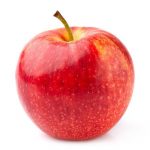 Neither of the two words that the ancient Romans had for apple—malum and pomum—are the source of the English name of this fruit. Instead, apple derives from a Germanic source, one likely related to Avella, the name of a famous fruit-growing region in Italy; however, whether the region was named after the fruit, or the fruit after the region, is unknown. In English, the word apple was first recorded in the ninth century, but at that time, and for centuries after, it was used to refer not only to apples in particular, but also to fruit in general: Aelfric, for example, the greatest prose writer of Old English, even referred to the cucumber as an apple. In the Hebrew Bible, the item which Adam and Eve are forbidden to eat is referred to only as “the fruit”; however, because apple could also mean fruit, translators of the Bible sometimes used it in place of fruit, causing later generations to suppose that the forbidden fruit eaten by Adam and Eve was an actual apple. Of the various sweet dishes made from apples, the one with the oldest name is apple-mose, an apple porridge first referred to at the beginning of the fifteenth century. Apple pie is not recorded in print until the end of the sixteenth century when it appears in a peculiar compliment invented by Robert Greene for his prose romance, Menaphon: “Thy breath is like the steame of apple-pyes.” Applesauce did not acquire its name till even later: the middle of the eighteenth century.
Neither of the two words that the ancient Romans had for apple—malum and pomum—are the source of the English name of this fruit. Instead, apple derives from a Germanic source, one likely related to Avella, the name of a famous fruit-growing region in Italy; however, whether the region was named after the fruit, or the fruit after the region, is unknown. In English, the word apple was first recorded in the ninth century, but at that time, and for centuries after, it was used to refer not only to apples in particular, but also to fruit in general: Aelfric, for example, the greatest prose writer of Old English, even referred to the cucumber as an apple. In the Hebrew Bible, the item which Adam and Eve are forbidden to eat is referred to only as “the fruit”; however, because apple could also mean fruit, translators of the Bible sometimes used it in place of fruit, causing later generations to suppose that the forbidden fruit eaten by Adam and Eve was an actual apple. Of the various sweet dishes made from apples, the one with the oldest name is apple-mose, an apple porridge first referred to at the beginning of the fifteenth century. Apple pie is not recorded in print until the end of the sixteenth century when it appears in a peculiar compliment invented by Robert Greene for his prose romance, Menaphon: “Thy breath is like the steame of apple-pyes.” Applesauce did not acquire its name till even later: the middle of the eighteenth century.
Apples are a fruit that can be grown in a wide range of locations throughout the world, including most parts of the United States and in temperate climates elsewhere. As a result, there are numerous varieties of apples available, which can be categorized into cooking and dessert types. These varieties possess unique characteristics in terms of taste, texture, and appearance, making them suitable for a variety of culinary applications. Whether baked into a pie or enjoyed as a healthy snack, apples remain a beloved fruit for many people around the world.
